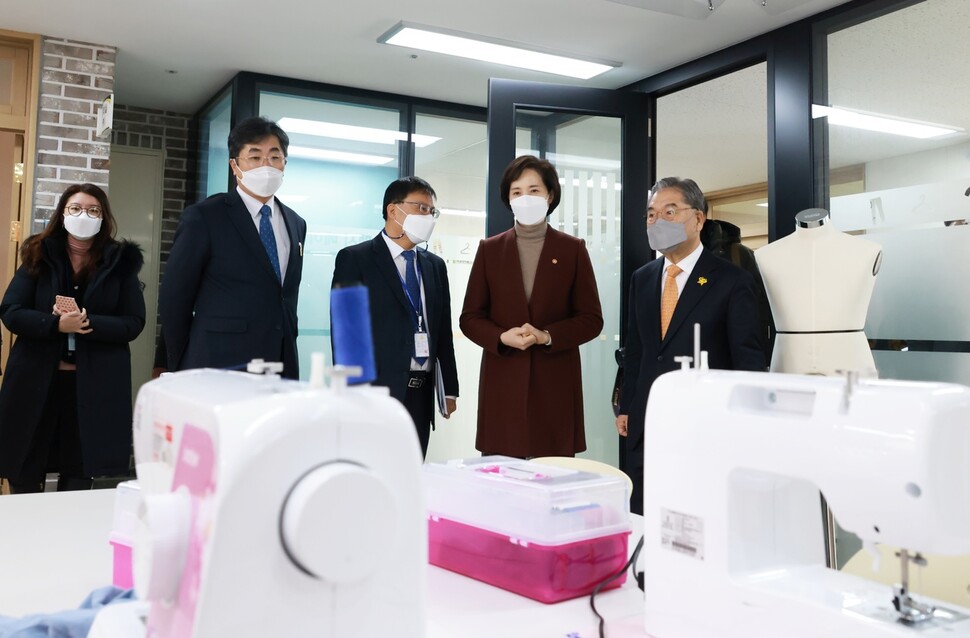
Deputy Prime Minister Yoo Eun-hye and Minister of Education (second right) and Gyeonggi Superintendent Lee Jae-jeong (far right) are looking around the school after completing a briefing on the’Comprehensive High School Credit System Implementation Plan’ held at Galmae High School in Guri-si, Gyeonggi-do on the morning of the 17th. Provided by the Ministry of Education
Education authorities have regarded the high school credit system as a key driver of future education in that it is possible to provide’customized education’ by guaranteeing student choice. The Ministry of Education is planning to begin discussing the revision of the national curriculum from this year and announce the ‘2022 revised curriculum’ next year, which will be applied to the school field from 2025 when the high school credit system is fully introduced. The reorganization of the high school replacement system, with the content of converting special subjects and self-accidents into general high schools, is also scheduled to be implemented in 2025. However, the success or failure of the high school credit system is expected to differ depending on how tasks such as measures for the supply and demand of teachers and reorganization of the college admission system are carried out.
Dasik Oh Ji-sik aims to break away from uniform education
The main purpose of the high school credit system is “customized individualized education centered on individual students”. In a briefing on the 17th, Yu Eun-hye, Vice Prime Minister of Social Studies and Minister of Education, said, “The changes in high school education in 2025 will lead to changes in college entrance examinations in 2028, and education in Korea will come from uniform education and competition-oriented education symbolized by the problem of SAT. You will escape.” Therefore, the key is whether students can actually provide the class and environment they want. If this is entrusted only to the capabilities of individual schools, there is a great concern that the gap between schools will only widen. For example, in rural areas where teachers are scarce, students may not be able to properly establish the elective courses they want, while schools in areas where students are immersed in college may exploit the high school credit system by creating many courses that are advantageous for college. Kim Seong-cheon, a professor at the Korea National University of Education, pointed out that “the system can only be settled at the level of the Office of Education when it takes control of the overall design and implementation of the high school credit system and establishes an environment beyond individual schools.” Above all, how to secure teachers and instructors whose demand will increase rapidly is regarded as the biggest challenge. A variety of elective courses, such as’Pilgrimage of the country’ in social studies and’humanities sensibility and understanding of history’ in the history course, are also offered. Because it should be. Since this year, the Ministry of Education has been assigned to the Education Support Office to assign’curricular teachers’ who go to various schools to teach. Revealed the measures. The demand for high school credit system is also reflected in the mid- to long-term teacher supply plan to be prepared by 2022. However, on this day, teachers’ organizations said, “The establishment of the high school credit system without the expansion of teachers is not good enough” (Korean Federation of Teachers’ Associations), “There is no plan to prevent the confusion of the teacher supply and demand system due to the guidance of multi-subjects and multi-subjects” (National Teachers’ Workers’ Union). They expressed concern about securing the quality of teaching and education.

Regular expansion and high school credit system contradict policy
There are also concerns that it is difficult to properly operate the high school credit system without the existing ranking competition and entrance exam-oriented education. Regarding this comprehensive plan, the Practical Education Teachers’ Association pointed out that “the consideration of non-entrance students to a four-year college is not clearly seen.” The high school credit system could be “just opening a course for the academic type (student division) specification,” he said, unless more earnest investments are made in opening vocational and liberal arts-related courses to make paths other than college entrance. Inside and outside the education world, it is pointed out that the’regular expansion’ promoted by the Moon Jae-in administration collides with the high school credit system that encourages individual diversity of students. The government has decided to increase the proportion of major universities in Seoul to 40% by the 2023 school year. The KTU argued that “high school credit system without improvement in the direction of’regular expansion’ is impractical.” Rather than the full introduction of the high school credit system, it insisted that a blueprint should come out first of how the achievement evaluation system will be reflected in college. Professor Seong-Chun Kim pointed out, “Even if the achievement evaluation system expands, if universities come up with strategies that put more emphasis on relative evaluation, such as ranking by subject, there is a concern that the high school credit system will become ineffective.” In response, the Ministry of Education said, “We will begin discussions on the future SAT and college admission directions that comprehensively reflect the new system.” It is a new framework for college admission in 2028 for students who are educated on the high school credit system from 2025. Another factor of concern is that 2025, when this change will actually happen, is left to the next government. Regarding this, Deputy Prime Minister Yu said, “Since the high school credit system was prepared by collecting opinions from the provincial and provincial offices of education, the consistency and continuity of the policy should be ensured regardless of how the government changes.” By Choi Won-hyung, staff reporter [email protected]
